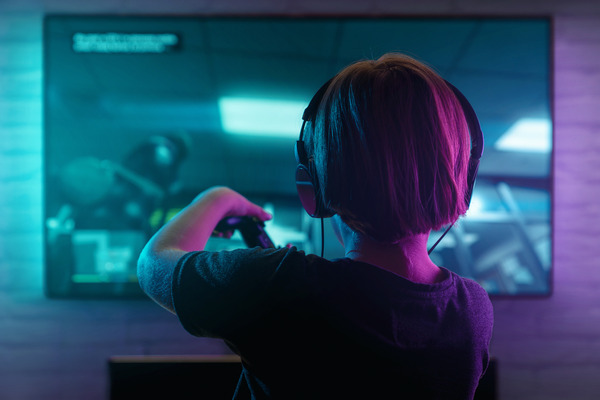
Without a doubt, Tetris is one of the most popular video games ever designed in the history of digital entertainment. By evoking its title, we can all visualize how its characteristic figures move to the sound of “Music A” (an arrangement in MIDI format of a song of Russian origin known as Korobeiniki).
Millions of children and adults from all over the planet have dedicated countless hours to it, because along with other icons (such as the well-known Mario and Sonic), it is part of the Olympus of a business area whose progression seems unstoppable.
It is such a well-known work that it has even given a name to a phenomenon of perception that is still the subject of much research today, but which we still seem to be far from fully understanding. It is none other, of course, than the tetris effect. Let’s see what it consists of.
What is the Tetris effect?
The human brain, like space or the ocean floor, is still a mystery to science. Although we are in a time of fascinating developments, even today we continue to ignore the organ that lives inside our head, exactly the same one that we must use to discover it.
When it was first described it was given a secondary role, the weight of conscience being placed in the heart. Today, however, we know that the brain is the organic support of everything we are, and that it is even capable of varying its form and function to adapt to what we do (if there is any difference between “being” and “do”).
Neural plasticity is a property of this organ that allows it to shape itself to efficiently distribute its own resources and adapt to the demands that different situations impose on it daily. Thus, both the structure and the activity of nervous tissues depend on what consumes our time. In this sense, habits are the architects of our thoughts and actions, through their enormous potential to define information processing in the long term.
Science has tried to discover how certain activities change the structure of the brain, and the resonances of all this on cognitive functions such as memory and/or attention. Tetris has been, without a doubt, the game that has been used most frequently in literature for this objective. In purely organic terms, some work has shown that playing it increases the density of the gray matter in the temporal and prefrontal lobes, basic for higher-order cognitive processes and memory or spatial vision.
Based on these findings, many other investigations were carried out to understand the effect of this “change” on cognitive dimensions. The literature indicates that incorporating Tetris into our habits can translate into an improvement in non-verbal learning processes, mental rotation of figures in two dimensions and the ability to reason in spatial terms. The practice is also likely to positively impact visual memory, and there are even studies that have found it useful in reducing the intensity and frequency of post-traumatic flashbacks.
Despite this, most of these effects still remain uncertified definitively, nor is it known how long they would last if they existed.
Everything reviewed could be a consequence of plastic changes in the brain parenchyma and would be potentially useful for the design of psychological intervention and neurological or neuropsychological rehabilitation programs.
Beyond the positive effects, however, there are also studies that have shown that playing this title for too long a day can lead to alterations in perception and in the various mechanisms that we use when processing the information coming from us. of the sense organs. This is so much the case that Tetris has become a research paradigm within cognitive psychology.
For this article, emphasis will be placed only on the last of such phenomena, which has been coined in scientific literature (and popular culture) as the Tetris effect. At the end we will also detail how it extends to different contexts, since we know that it can also occur in other daily activities.
How is it expressed?
Tetris is a game that has the ability to “hook” its users, given that it consists of simple and addictive mechanics. It consists of a succession of geometrically very simple pieces that move in a vertical scroll (from top to bottom). The user’s role is to stack them so that they fit perfectly, taking into account its composition and without leaving empty spaces between any of them. When the task is carried out correctly, the system “rewards” us by eliminating the accumulation of pieces, since our ultimate goal is to prevent them from taking up the entire screen. At that time the session would end and the total score obtained would be counted.
As time passes without the game having been completed, the speed of the game accelerates (and also the accompanying music) and progression becomes more difficult. As you can imagine, the user remains staring during the game, attentive to a repetitive and constant procession of stimuli. This is how the fundamental criteria are reproduced for the effect at hand, which we will now describe by areas, and which could flood our thoughts or intrude into the unfathomable world of our dreams. Even so, it must be noted that its effects occur for very short periods, and therefore are generally reversible.
1. Perception of reality
An effect that some users describe after playing Tetris for a long time is that your way of perceiving reality changes somehow. The descriptions on this issue coincide in pointing out that there is a “transfer” of the task required during the game to real life, in which the objects that make it up begin to acquire a more polygonal and simple nature.
Although they continue to be captured exactly the same through the sense organs, their characteristics change throughout the processing of their properties, emphasizing the outline of their global silhouette and ignoring the details (cubes, rectangles, circles, etc.) .
The person is still able to perceive the details of the object, but with a kind of heightened awareness of its elemental polygonality. As a direct result of all this, he usually tries to imagine how his surroundings could “fit or adjust”, transferring the habits acquired in the game to his own real life. The most common thing is that the horizon begins to be perceived as the tower of Tetris pieces, and that the outline of the elements found around it is scrutinized to determine how they could be assembled. The same thing can also happen in the organization of the elements of a house, or in the parking spaces that are reserved for vehicles.
In some cases, the person might even catch themselves trying to stack the objects around them in a similar way to how you would do it in a game of Tetris. In this case, perceptual changes would have their impact on behavior. Fortunately, it is not the most common.
2. Intrusion
In addition to what has been mentioned, some Tetris users point out that, after having been playing for several hours, they continue to perceive the movement of the pieces despite having ended the game.
It is common for this sensation, which is labeled ghosting, to increase when the eyes are closed or we find ourselves in dark places (where any visual reference to the environment is lost). The characteristic music of the game could also remain, being heard in a “loop” even though it is no longer in the perceptual field. It is for this reason that in the scientific literature on this matter it has been considered a form of hallucination, despite the fact that clear awareness of its mental origin is maintained.
Finally, some people also end up dreaming about the Tetris pieces falling over and over again, without end or objective, the inertia of habit dragging them to the same dream scenario.
Causes
The Tetris effect occurs as a direct result of prolonged, repetitive exposure to a specific activity, to which a significant effort has been directed in the hours prior to its emergence. It is common after very long days of work in which the visual field was reduced to a pattern of simple stimuli and repetitive presentation or, under the assumption at hand, after a marathon or excessive game of the game itself.
In any case, it seems to be an alteration in the processing of information that is due to habits that have become established in everyday life, to the point of ending up mixing with everyday life in an intrusive and/or parasitic way.
Appearance of this psychological phenomenon in other contexts
Any activity in our daily lives that tends to be carried out for a long time, and whose characteristics are extremely simple and repetitive, is likely to cause effects similar to those described for Tetris. Although the phenomenon was popularized through the game, refers to a reality of human processing that extends beyond it and that is reproduced by stimuli that harbor the indicated qualities.
Thus, someone who writes could find themselves invaded by lines of text on the white background of the computer, and someone who works as a cook could keep a view of their work table even when they go to bed.
The stimuli that trigger it are, therefore, enormously varied. And in any case, they will describe the way in which the human brain adheres to habits and the possible neuroplastic effects that underlie this (which remain largely unknown).








